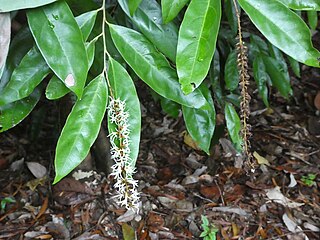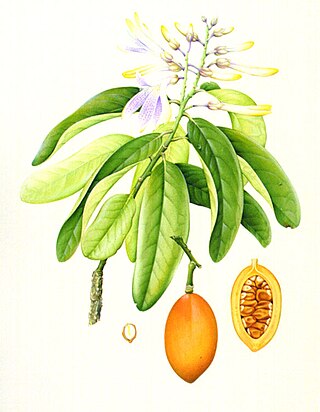
Normanbya is a monotypic genus of palms containing the single species Normanbya normanbyi, which is known by the common name black palm It is endemic to Queensland, Australia and is threatened by habitat destruction.

Helicia australasica, also known as Austral oak or creek silky oak, is a species of rainforest tree in the macadamia family Proteaceae, native to New Guinea and northern and northeastern Australia.

Huberantha nitidissima, commonly known as canary beech or shiny leaf tree, is a plant in the custard apple family Annonaceae. It is found in seasonal tropical forests and along moist watercourses in New Caledonia, Vanuatu and the Australian states of New South Wales, Queensland, and the Northern Territory.

Endiandra discolor is a tree in the family Lauraceae, native to eastern Australia from central New South Wales to northeastern Queensland. Common names include rose walnut and domatia tree. It grows in tropical, subtropical or warm temperate rainforest, particularly on the poorer volcanic soil types, and alluvial soil near streams. It was first described in 1870, and has been given the conservation status of least concern.

Endiandra compressa, commonly known as whitebark or greenheart, is a rainforest tree in the Lauraceae family endemic to eastern Australia. It was first described in 1919 and has been given the conservation status of least concern.

Eupomatia barbata, also known as the small bolwarra, is a species of plant in the primitive family Eupomatiaceae. It is endemic to Queensland, Australia, and was first described in 2002.

Neostrearia is a monotypic genus - i.e. a genus containing only one species - of plants in the witch-hazel family Hamamelidaceae. It is the second described of three monotypic Australian genera in this family, the others being Ostrearia and Noahdendron. It is most closely related to these genera, as well as Trichocladus from southern Africa and Dicoryphe from Madagascar, and together these five genera form a distinct clade within Hamamelidaceae.

Acalypha lyonsii, commonly known as Lyon's acalypha is a shrub in the spurge family Euphorbiaceae that is only found in the vicinity of Cairns, Queensland, Australia.

Alstonia muelleriana is a tree in the dogbane family Apocynaceae which is native to southern Papua New Guinea and northeastern Queensland.

Alyxia oblongata, commonly known as the chain fruit, prickly lixy, or prickly Alyxia, is a plant in the dogbane family Apocynaceae endemic to a small part of northeastern Queensland.

Fagraea fagraeacea, commonly known as yellowheart or pink jitta, is a plant in the gentian family Gentianaceae which is native to New Guinea and Queensland.

Polyosma rhytophloia, commonly known as wrinkled bark polyosma, is a plant in the family Escalloniaceae which is endemic to parts of eastern Queensland, Australia. It was first described in 1926.

Debregeasia australis, commonly known as china grass or native ramie, is a plant in the nettle family Urticaceae endemic to Queensland, Australia.

Xanthophyllum fragrans, commonly known as fragrant boxwood, is an evergreen plant in the family Polygalaceae found only in the Wet Tropics bioregion of Queensland, Australia.

Aceratium megalospermum, commonly known as bolly carabeen, creek aceratium or carabeen, is a plant in the family Elaeocarpaceae found only in the Wet Tropics bioregion of Queensland, Australia.

Balanops australiana, commonly known as pimplebark, is a plant in the family Balanopaceae found only in the coastal regions of northern and central Queensland, Australia.

Saurauia andreana, commonly known as Andre's saurauia, is a plant in the family Actinidiaceae found only in the Wet Tropics bioregion of Queensland, Australia.

Rhodamnia sessiliflora, commonly known as iron malletwood, is a small tree in the eucalyptus family Myrtaceae, found only in the Wet Tropics bioregion of Queensland, Australia.

Myrsine subsessilis, commonly known as red muttonwood, is a plant in the family Primulaceae found only in coastal rainforests of New South Wales and Queensland, Australia.

Claoxylon angustifolium, commonly known as narrow leaf claoxylon, is a plant in the family Euphorbiaceae found only in Queensland, Australia. It is a shrub which will usually grow to a height of about 4 m (13 ft), with long narrow leaves up to 22 cm (8.7 in) by 2 cm (0.79 in). The flowers are small, about 2 mm (0.08 in) diameter, and the fruit are capsules, green when ripe, and about 6 mm (0.24 in) long by 8 mm (0.31 in) wide. It was described in 1865 by Swiss botanist Johannes Müller Argoviensis. Its natural range is from the Mount Windsor National Park west of Mossman Gorge, south to Eungella National Park west of Mackay

























